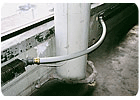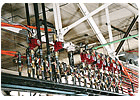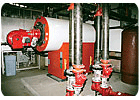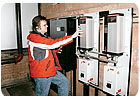
Formerly an old Chicago manufacturing facility, Able Distributors' new warehouse was basically bought on an old-fashioned handshake. Unfortunately for the Bleier brothers, co-owners of Able Distributors, they didn't know what they were getting into when they purchased the building in 2003. The Able central stocking warehouse can be found at 5610 Bloomingdale on Chicago's northwest side. It is a building that is roughly 60 years old and located in an area that has been “neglected due to the growing movement of manufacturing to the suburbs and overseas. But we believe the area is ripe for a comeback and we're proud to be contributing back to the community,” says Michael Bleier, co-owner and vice president.
The decrepit building, which includes the warehouse and an adjacent four-story structure, was in such a state of disrepair that it presented both problems and opportunities. A daunting amount of work was needed to bring it back to use. The good news is this gave Able a chance to “practice what we preach,” says Bleier.

“It Was A Mess”
Distributors has been a distributor specializing in hydronic and radiant for more than 20 years. It was founded in 1980 by Andrew Bleier in an 800-sq.-ft. storefront space on Chicago's northwest side. This is still the company's headquarters, currently occupying 60,000 square feet. Bleier's sons, Daniel and Michael, now run the business. It has expanded by leaps and bounds and a large reason is its radiant hydronics business. There are three other locations in the Chicagoland area, including their latest endeavor.As Able's largest warehouse, the new 120,000-sq.-ft. building was bought in late 2003 and according to Michael Bleier, “it was a mess.”
“Walking through the building after we shook the other gentleman's hand, we realized that the roof had serious problems, the windows were hardly what you would call windows and we had inherited a heating system from probably the turn of the century,” he says. The system consisted of three old Kewanee steam boilers with a total of 12 million Btus. Eventually this building would turn into a testing lab for what Able does for its customers on a regular basis.
“The building was in a complete state of disrepair,” says Bleier. “We replaced all windows, alarm systems, HVAC, roof, etc.”
After preliminaries were out of the way, Bleier discussed the problem of the heating system with Piotr Zelasko, the company's first-rate design department manager. Initially, the idea was to put in a couple of steam boilers to replace the old Kewanee behemoths. They even thought about localizing some of the heat. That's when Zelasko suggested converting the whole building from steam to hot water. This would enable them to gain much more control over modulating the temperature. They would use condensing boilers, zone the building and basically “practice” what that they design when doing jobs for customers.

Roof Renovation
As it turned out, the roof needed more urgent attention than the windows. Its surface consisted of built-up tar and gravel. In addition, there were missing, damaged or otherwise non-working drains causing massive rainwater retention and more problems. New water drain intakes and lines were installed during the renovation. The roofs on both the warehouse and the four-story building were torn-off and replaced with new single-ply EPDM roofs and surfaced with a reflective coating. This helps to keep the weather elements out and as a result, Able has gained energy savings from improved thermal insulating properties of the new roofing.
Warped Windows
All existing windows were circa 1920-putty glazed industrial, steel sash units. The combination of time and lack of attention from the former owners left entire sections of glass on the brink of collapsing. “Many windowpanes were cracked, missing or patched with anything but glass,” says Zelasko. Work was completed in phases starting in January and ending in May 2005. All existing windows were removed, new units were prefabricated prior to demolition work and installed while the old ones were taken out. With the new windows in place, the building has an extremely low infiltration envelope with improved thermal performance.Zelasko adds, “The new system is a good compromise between the requirement of delivering a significant improvement over the existing situation and keeping the budget necessary for dealing with our prime goal, which was the complete modernization of the HVAC system.”

An Idea Takes Shape
The combined effect of the thermal envelope improvements (windows and roof) enabled the distributor to downsize the heating plant. But before deciding on a whole building conversion, they considered simpler options, such as replacing the old Kewanees with new steam boilers. Knowing that energy costs were going up, that idea was replaced with abandoning the building's steam system altogether.Direct fire, individually vented appliances would be the lowest-cost approach, but besides the warehouse they also had to think about their tenant's office building. After taking a look at how the building was set up and evaluating how much of the connected pipe throughout the building they felt was usable, they made the stretch to convert it to what they do all the time, which is to design super-efficient hydronic systems. They researched the potential energy cost and decided that hot water would be the better choice when coupled with the right equipment. This changeover was underway when we visited them last January. The project is estimated to take two full years to complete, with a ballpark price tag of $250,000. According to Bleier and Zelasko, Caleffi North America (see box below) and several other manufacturers gave them considerable support in helping to bring this project about.

The Heart Of The System
Inside the now warm and comfy warehouse, a single Viessmann Vertomat boiler replaces all three ancient steam behemoths. Able wanted to preserve as much of the existing infrastructure in the building as possible, such as unit heaters, heating coils and fin tube elements.They agreed that the heating plant had to make the most economical sense in terms of the lifecycle cost and chose a Vertomat condensing, fully modulating boiler.
The actual boiler plant consists of two independent boiler units - Viessmann Vertomat as a primary source and a stand-by modular copper fin boiler sub-system. The boiler room has been revamped except for the DHW (domestic hot water) heating, which is next in line for upgrading work, and is still in progress at the time of this writing. The new DHW solution is based on Viessmann's indirectly fired storage tank using energy from the boiler.


Internet Control
Future plans for the new warehouse include a controls system for the entire building, as well as having the building controllable online. Able intends to use i-Worx from Innovex Technologies, a self-configuring LON-based, Web-enabled system.The system will consist of the HVAC controls with potential to add lighting and door access modules down the road. With centralized access, they will be able to monitor and adjust the set points and the schedules from a single interface point.
“I am excited about having the ability to see how the building is doing from any device with Internet access. The system will be programmed to send alarm notifications via email,” Zelasko says.
Even with their ability to buy the system at wholesale pricing, Bleier admits they needed some help from manufacturers to pull off the ambitious project, and they were concerned about the reaction. Luckily, most of their manufacturers were enthusiastic about the project.
Able has invested a lot of time and a significant amount of money to do for themselves what they so strongly believe in for their customers.
They found the most efficient condensing boiler they could, using as much radiation as possible. The strategy was to drive the water temperature way down and get back energy savings that soared through the roof.
They predict a payback on the system in less than five years from reduced fuel consumption and maintenance costs. “Our goal was to set up a showcase for what we believe in and what we do,” says Bleier. “ It's a huge investment for us.”

Robert Wachala, mechanical contractor, R.W. Heating & Cooling Inc.
As the contractor on this project, Robert Wachala found the biggest challenges in trying out new technologies and materials while designing around water temperature, piping size and water distribution. His ability to improvise on such projects has helped to make hydronics Wachala's specialty. He has worked with Piotr Zelasko on radiant heating jobs for more than 10 years.He attributes skyrocketing gas prices for the growing interest in hydronic heating these days. “As gas prices go up, a lot more people are interested in new and energy-saving hydronic systems. It's no longer a luxury item but something they can save money on. The payback time is coming down to just five years, from about 15 years,” says Wachala. “This building is a proving ground for a lot of different solutions that will make it interesting and challenging [to work on].”



